Spring has been a disappointment for sun loving human beings in this part of the world so far. It has been constantly cold, wet and dull almost since Easter. Yet, many plants (although not the garden vegetables, which are now severely behind) seem to enjoy this “wettest drought on record”, as long as they are able to hold back their flowering activity. 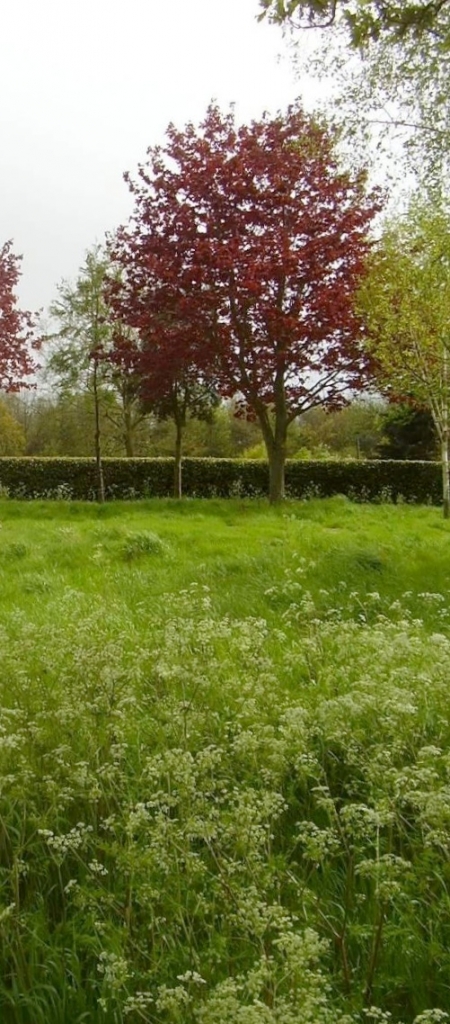 Everything appears to be freshly painted, only the paint won’t get dry. The grass looks fresh and green everywhere, evoking picture postcards of Ireland, although it doesn’t seem to grow very fast because it is too cold.
Everything appears to be freshly painted, only the paint won’t get dry. The grass looks fresh and green everywhere, evoking picture postcards of Ireland, although it doesn’t seem to grow very fast because it is too cold.
Although I preferred a much milder spring I am at least grateful that it saves lawn mowing activities, by myself and by others. I might be wrong, but the noise level in suburban and other gardens is apparently down and the birds’ songs appear to be more intense.
Grass cutting and making the corresponding noise, it seems, is more beloved by male “gardeners” of some predisposition. One would see instant results and can return again and again a proud man with a job done within a well-defined time to a well-deserved meal and an adoring family. I wonder whether this is in the genes or somewhat connected to (also male dominated) past times like football, cricket, golf or motor racing, which also require uniform and monocultural surfaces.
Of course, grass paths and areas between borders enliven the scene and create soft green contrasts, and we need places to have a picnic or even areas to park cars, and those are better kept short. In any case, I very much prefer contemplative weeding and if I could, I would happily kick mowing activities into the long grass or at least try to make those tasks as interesting as possible. For instance by just mowing paths which could be woven into an interesting or flexible pattern.
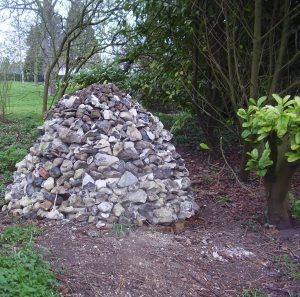
The original cairn with the rubble and bricks inside the flint mantle
Here is an example from an area which is large enough to experiment on, although there could be scope for smaller areas, too, perhaps even in city gardens. It is almost possible to call this a rehabilitation project since not long ago it was being disfigured by football goal posts. As seems to be a pattern with my activities on this project, it has not been designed but just happened or developed out of being in an environment for a while without trying to “improve” things immediately. And it rather started with a mishap: During my transformation of an old rose garden into a herb garden I constantly dug out old stones and rubble, partly because it had been built in an area of former cattle sheds. Only after I had wheeled barrow loads of those away it occurred to me that I might as well build a “monument” of my toil and started to erect a cairn which took shape over the months under an old ash tree, which I thought would be a suitable place or even a focus point.
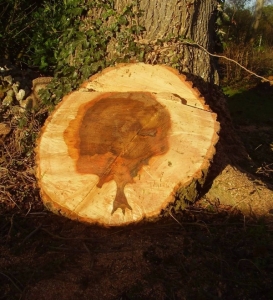
A cross section of the ash showing its “heart”
Only that I did not reckon with a severe winter gale last December which shook and misbalanced the ash tree so much that it needed to be pollarded. Whereas the cairn survived the gale unscathed, it was not possible for the tree surgeons to be as “careful” and my monument was being transformed into a mere rubble heap. Yet there was an interesting consolation if not miracle since they revealed during their cutting down procedure the so-called heart of the tree, which, they said, sometimes even shows leaves.
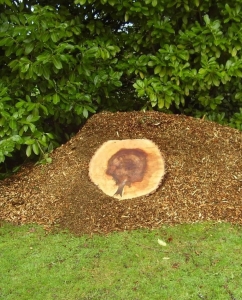
The “tree heart” lying on a heap of very useful mulch which is now the surface of some woodland walks
Unfortunately (or fittingly?) the heart pieces broke as it was drying and while I was still considering what to do with them (without the end product bordering on the twee). In the meantime I was wheeling my rubble to a different and more prominent position which I found could become a good centre piece for an informal turf labyrinth (not a maze yet!) which would mirror the more formal paved thyme labyrinth in the herb garden.
The labyrinth idea was already in my head since I was not quite pleased with the appearance of this former quasi football field, which was neither a lawn nor a meadow. And now the gods of the wind delivered me a centrepiece to which I could return with bucket loads of stones gathered by weeding or digging elsewhere. I almost felt like worshipping local ancestors of the region who thousands of years ago mined flint in this region. Flint is the main and almost only stone to be found in Norfolk, hence the typical vernacular building technique, but it was also used for tools or weapons. There is an interesting and unique English Heritage site not too far away. The old mining shafts look like a moonscape from above.
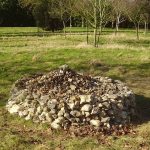
The stone cairn is gathering height

As spring approached I found I should stop the building up process for two main reasons, first because there would be more proper gardening work to do and second, the way to the centre would become slightly longer if I wanted to mow a labyrinth. So I finished the building and put a piece of ash tree cross section on top of it, anticipating that the flat surface could be put to good use for further pilgrims.
Two weeks later (mid May) it’s more colourful and lush on the ground and above.

From a different tree (all of them far enough away not to crash on the cairn)

From another angle, somewhat opposite
Now came the question of the shape and direction of the labyrinth and whether I should properly construct it or rather let the lawn mower decide. For this I needed and wanted the grass to grow a little faster in the first place, which of course contradicts everything I said at the beginning. In principle I decided that a separate entrance and exit could be a good idea, both of them roughly opposite each other to link the labyrinth with the surrounding paths. Thus it should be possible to enter at one point and exit at the other end or for two people to enter at opposite ends to circle around one another and meet in the middle and exit together, or separately. And off the mower went, starting from the centre with a circle.
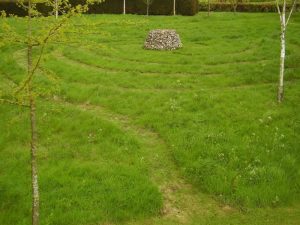
The mown labyrinth exit (or entrance)
What is nice about these mowing antics is that the figures can be changed (or scrapped) from year to year. An idea so far is to leave the first middle rings approximately round but lead the last rounds more adventurously around the area or surrounding trees. Or to have exit and entrance side by side. Or to have a sister labyrinth (or maze, this time?) somewhere else?
In any case, mowing has become an excitement in this case and not necessarily worse than weeding. It doesn’t take longer than 10 minutes for the whole area, unless one is distracted by something.
Which should be one of the pleasures of gardening. Shouldn’t it?
[Listen to Bernhard’s audio to hear his daytime garden alive with birds – as well as postscript nighttime recording called ‘Our place at night – wind, owls and nightingale’]https://gardendrum.com/wp-content/uploads/2012/05/GardenDrum-Bernhard-Feistel-A-bearable-version-of-grass-cutting-a-turf-labyrinth.mp3
